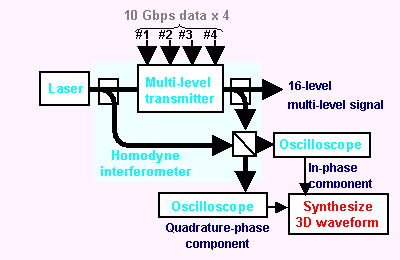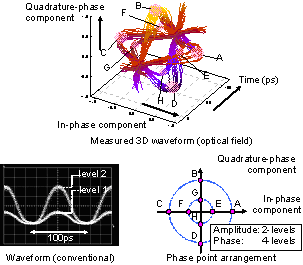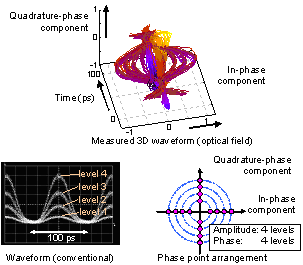
 |
 News releases News releases |
 |
 |
 |
  PDF Download(PDF Type, 35Kbyte) PDF Download(PDF Type, 35Kbyte) |
 |
 September 27, 2005 September 27, 2005 |
 |
| 3D Visualization of amplitude and phase of high-speed optical signals |
 |
| - Major progress in realizing next-generation optical communication networks - |
|
 |
Tokyo, 27th September 2005 --- Hitachi, Ltd. (NYSE:HIT / TSE:6501) announced the successful development of a three-dimensional (3D) visualization technique to observe the amplitude and phase of high-speed optical signals in optical fiber communications, for the first time in the world. New methods of transmitting information using the phase of light (optical phase) through optical phase modulation or multi-level modulation, are being considered for next generation optical fiber networks. In order to facilitate these developments, however, it is necessary to be able to observe a complete phase modulated waveform to determine its quality, and thus initiate improvements. Optical phase (time delay of the optical wave) however was "invisible" to conventional instruments, preventing observation, and thus hindering significant progress. The 3D visualization technique developed will be a key to facilitating the development of large-capacity long-distance next-generation optical transmission technology for application in optical networks.
With the proliferation of the Internet and increasing availability of broadband technology such as ADSL *1) and
FTTH *2), a steady increase in the amount
of information being transmitted across wide-area
(intercity) and metropolitan-area (intra-city)
optical networks, can be expected. In conventional
optical networks, binary amplitude modulation
is used, whereby the signal (information)
is represented and carried using two amplitude
levels (High and Low). In order to increase
the information traffic carried along a single
fiber, modulation speed needs to be higher,
up to 10 or 40 gigabit-per-second (Gbps)
and beyond. Such high-speed signals, however,
hit an obstacle of limited transmission distance,
since the ultra-short optical pulses used
in the high-speed amplitude modulation are
easily distorted even after transmission
across a short segment of optical fiber (from
several to several tens of kilometers).
New methods such as optical phase modulation or multi-level modulation have been proposed to achieve larger capacity and longer distance, and in September 2003, Hitachi demonstrated the feasibility of multi-level modulation using both amplitude and phase modulation, such as 8-level modulation *3) to achieve triple capacity, and in 2004, 16-level *4) for quadruple capacity, to increase the amount of information traffic without increasing the modulation speed. To further develop and improve such phase-modulation and multi-level modulations techniques, the ability to precisely analyze waveforms, as is commonly conducted for amplitude-modulated signals using state-of-the-art optical waveform-measurement instruments, is indispensable, however this was being hampered by the "invisibility" of optical phase modulation.
To overcome this problem, Hitachi developed and successfully demonstrated a 3D visualization technique for the amplitude and phase of high-speed modulated optical signals. Features of the technique are as below:
| (1) |
Precise optical field measurement technique using self-homodyne interferometry *5) |
 |
To observe all the information of a high-speed optical signal, a self-homodyne interferometer is used to measure both the in-phase and the quadrature-phase field components of the optical signal at the same time. Further, in order to achieve high precision measurement, each signal component is averaged to remove the noise component. |
| (2) |
Three-dimensional visualization technique of optical field waveform |
 |
To enable intuitive interpretation of the transition pattern of high-speed optical signals, including the phase-modulated signals and the very complex multi-level signals, a three-dimensional optical waveform is synthesized by combining separately measured in-phase and quadrature-phase field components. This enables the precise analysis and easier understanding of the conventionally invisible impairments of phase-modulated optical signals. |
The above techniques were used to successfully observe 30 Gbps 8-level and 40 Gbps 16-level optical signals, and will be used to analyze and improve current phase-modulated and multilevel modulated optical signals, as well as develop practical transceivers for these modulations.
These results will be presented at the 31th European Conference on Optical Communication (ECOC
2005), to be held in Glasgow, Scotland, from 25th - 29th September 2005.
| Technical Terms & Notes |
| *1) |
ADSL (Asymmetric Digital Subscriber Line): A broadband communication method for subscribers using ordinary/existing telephone lines. ADSL enables high-speed data transmission of several Mbit/s to several tens of Mbit/s, and is used, for example, for Internet access and IP telephones. Subscription is widespread, with Japanese domestic users exceeding 10 million. |
| *2) |
FTTH (Fiber-to-the-home): A broadband communication method where optical fibers are installed directly into the home. FTTH enables extremely high-speed data transmission achieving 100 Mbit/s, and is used for Internet access and video distribution. Subscription is rising, with Japanese domestic users exceeding 3 million. |
| *3) |
Shigenori HAYASE, Nobuhiko KIKUCHI, Kenro SEKINE, and Shinya SASAKI, "Proposal of 8-state per symbol (binary ASK and QPSK) 30-Gbit/s optical modulation/ demodulation scheme," ECOC 2003, paper Th2.6.4 (presented September 2003). |
| *4) |
Kenro SEKINE, Nobuhiko KIKUCHI, Shinya SASAKI, Shigenori HAYASE and Chie HASEGAWA, "Proposal and Demonstration of 10-Gsymbol/sec 16-ary (40 Gbit/s) Optical Modulation / Demodulation Scheme," ECOC 2004, paper We3.4.5 (presented September 2004). |
| *5) |
Self-homodyne interferometry:
This is a technique to observe an optical field component, by interfering the observing signal with a part of light which is divided from the same optical source.
|
| About Hitachi, Ltd. |
| Hitachi, Ltd., (NYSE: HIT), headquartered in Tokyo, Japan, is a leading global electronics company with approximately 347,000 employees worldwide. Fiscal 2004 (ended March 31, 2005) consolidated sales totaled 9,027.0 billion yen ($84.4 billion). The company offers a wide range of systems, products and services in market sectors including information systems, electronic devices, power and industrial systems, consumer products, materials and financial services. For more information on Hitachi, please visit the company's website at http://www.hitachi.com. |
 |
| Fig.1 Set-up of 3D waveform (optical field) measurement |
 |
| Fig. 2 Observation of 30 Gbps 8-level optical signal |
 |
| Fig. 3 Observation of 40 Gbps 16-level optical signal |
|
|
 |
| Information contained in this news release is current as of the date of the press announcement, but may be subject to change without prior notice. |
|
 |
 |
PDF files are in Adobe's Portable Document Format. To view them you need Adobe(R) Reader(R) by Adobe Systems Incorporated. |
|
 |
|
 |
|